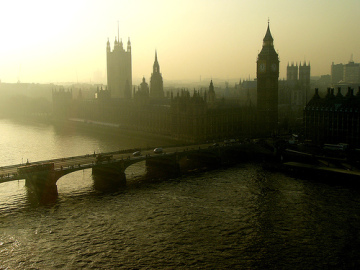More of a whimper than a bang: Whitehall's green tech drive

Public sector's carbon footprint goes down a size: but is the government really serious about making its IT infrastructure more eco-friendly and do the figures add up?
The government has trimmed the carbon footprint of its technology infrastructure - but questions remain about its plans to make its IT systems carbon-neutral by 2012.
According to an announcement by the Cabinet Office this week, the government has cut the carbon footprint of central government computers by 12,000 tonnes and saved at least £7m over the past year by making its IT systems greener.
However, the 12,000-tonne saving represents a tiny fraction of government IT's carbon emissions - equating to just 2.6 per cent of the 460,000 tonnes that Whitehall IT generates each year.

The government has only cut a fraction of its IT carbon emissions
(Photo credit: ktylerconk via Flickr.com under the following Creative Commons licence)
The £7m saving is also dwarfed by the £14bn the government spends on technology per year. The Cabinet Office said these figures only represent a snapshot and not the full extent of the savings derived from greening its IT but could not provide details of any further savings.
In a speech to a government green IT conference on Tuesday, Cabinet Office minister Angela Smith said IT is "one of the hidden causes of climate change", with worldwide IT responsible for the same level of carbon emissions as the airline industry.
Smith said that "real progress" has been made by the government in tackling the "huge environmental and financial costs of computer use", adding that in just 12 months it has saved enough carbon dioxide to fill almost 2,500 Olympic-sized swimming pools.
IT is responsible for up to 20 per cent of carbon emissions generated by government offices.
In its Greening Government ICT report published last year, the government set targets of making its ICT carbon neutral across its lifecycle by 2020 and making the energy consumption of its IT carbon neutral by 2012.
The 2012 target is missing from a progress report on the Greening Government ICT strategy, published yesterday by the Cabinet Office.
A Cabinet Office spokeswoman said the 2012 target is still being worked to but is being reviewed in the light of action plans that have come in from government departments.
So far 110 public bodies have produced green ICT action plans establishing measures for improving the energy consumption and carbon cost of their ICT, using 22 specific actions recommended in the Greening Government ICT Strategy.
Recommendations include turning off all machines at night, extending the lifecycle of hardware, reusing as much IT equipment as possible and increasing server efficiency.
But progress so far has been mixed: the progress report said more than three-quarters of central government departments have completed or have in progress 11 or more of the recommended actions.
A further two actions - apply thin client technology and apply timer switches to non-networked technology and printers have been completed by less than 15 per cent of departments.
Mark Davison, head of public sector at IT services company Getronics, said: "If the central government estate is to be carbon-neutral by 2012 as the target states, there needs to be far greater progress made from this point on."
The government's list of recommendations for cutting carbon emissions from IT, published in the Greening Government ICT report last year, include:
For PCs and laptops
- Remove active screensavers, because these use as much energy as when the screen is in full use
- Switch monitors to standby after five minutes of inactivity to prevent a longer period of wasted power
- Shut down PCs after office hours
- Enable active power management on desktops (standby/hibernate after a defined period of inactivity)
- Ensure reuse of equipment that is no longer required but is still serviceable, or recycle or ensure green disposal. The majority of energy in the life of a PC or laptop is consumed in its manufacture, delivery and disposal
- Use low-power consumption CPUs and high-efficiency Power Supply Units (80 per cent conversion or better)
- Apply thin client technology because this is less complex than a PC and contains fewer components, increasing its life over that of a normal PC and reducing maintenance and support costs and thus energy consumption
- Apply timer switches to non-networked technology and printers, as not all equipment can be networked and/or automatically shut down or put into standby mode
- Set default green printing including duplex and grey scale
- Optimise power-saving sleep mode on printers
- Printer consolidation
- Reducing the number of printers and replacing those left with networked multi-function devices e.g. combined printers/copiers, can significantly reduce energy consumption.
- Device consolidation
In datacentres
- Server optimisation: implement storage virtualisation and capacity management
- Convert existing physical servers to virtual servers and turn off servers outside their service level agreement, subject to a phase loading and chiller unit risk assessment
- When designing and provisioning new services, create virtual servers instead of procuring physical new servers
- Implement a multi-tiered storage solution, much of the data spinning on disks today is seldom accessed
- Reduce cooling in the datacentre to appropriate levels and increase the ambient room temperature: over 50 per cent of the power associated with the datacentre is used for cooling the ICT equipment
- Identify servers and data disks in the datacentre that are running but not providing any services and decommission
- Specify low-power consumption, low voltage servers high-efficiency power supply units (80 per cent conversion or better)
- Ensure reuse of equipment that is no longer required but is still serviceable
- Datacentre audit to identify mismatches between the current physical layout and the layout that would maximise the effectiveness of cooling from air conditioning units